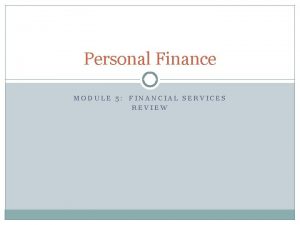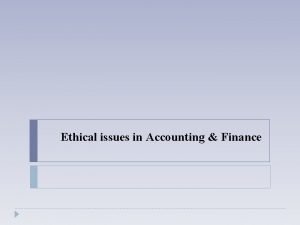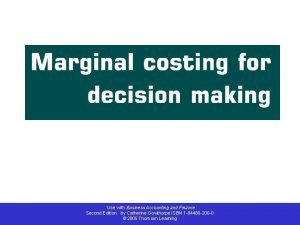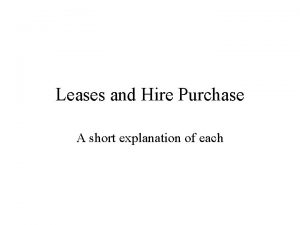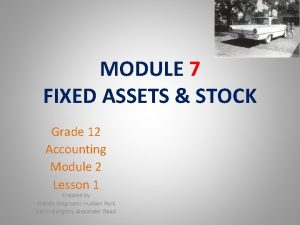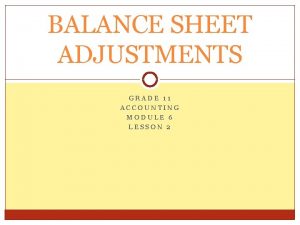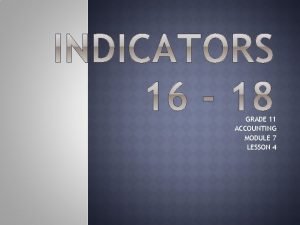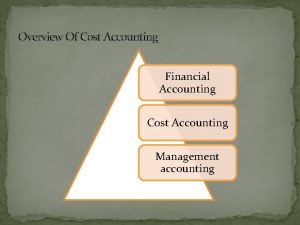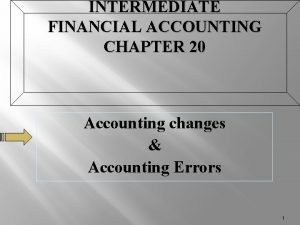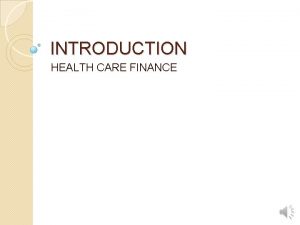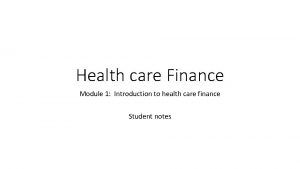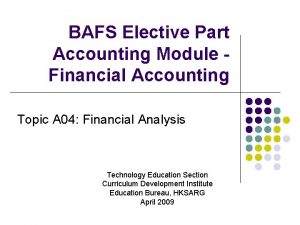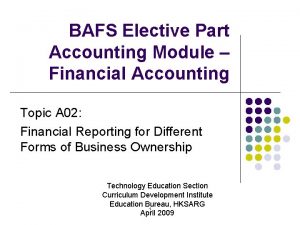Module 3 Financial Accounting Health care finance Financial





















- Slides: 21

Module 3: Financial Accounting Health care finance

Financial accounting basics, concepts, and assumptions

Understand the rudiments of accounting & Why do financial managers need to know accounting • Rudiments of accounting • Accounting is the language of business • Books = provide characters = finance = gives us a story • Financial statements provide the clearest picture of the past financial health of the firm • Knowledge of financial accounting is important for the manager who is involved in cost analysis and budgeting • Financial managers need to analyze the accounting records to. . • Review Power. Point • Understand how things have worked in the past • Understand the effects of a course of action • Cost and benefits of an action

Understand the fields of accounting practice • Financial accountant = designs procedures for the recording of transactions, supervises that record-keeping function, and is responsible for summarizing records in financial statements • Financial reporting • Company as a whole (Example Emory Health System) • Managerial accountant = take information about the costs of doing business from the financial records. Once information is gathered, they analyze it to find out how costs change with changing volume and how well management is doing at controlling costs • Budgeting and variance analysis • Units/clinics (Primary care clinic) • Auditors = responsible for verifying that financial statements are prepared with GAAP • GAAP • Internal auditor = ensure that adequate records are maintained to support the financial statements that the organization presents

Know the Health care financial management professional organizations • HFMA = Education and professional certification program • CHFP = Certified (minimum) • FHFMA = Fellow (Advanced) • Although many senior financial professionals do not hold them, are widely recognized • Look them up – great stuff like Revenue Cycle Management

Understand accounting principles • Basic accounting equation = Assets = liabilities + owner’s equity • Assets = all things (tangible and intangible) that in possession to help run the business • Tangible vs. Intangible • Current/Long-term • Liabilities = all items that the entity owes to other • Current/Long-term • Owner’s equity = difference between the value of the entity’s assets and its liabilities. It is what could be claimed were owned that could be liquidated • NFP do not have equity = net assets

Continued • Monetary terms = all items must be written in terms of money • Example: What vehicles are in possession • MONETARY UNIT USD • ACCOUNTING ENTITY – Identify what organization you’re talking about • Simple • Complex • ACCOUNTING PERIOD length of time of the financial statement • Month, quarter, year • Fiscal year • Oct-sept = Gov’t • Jan – Dec = Personal • August – July = Education

Continued • FULL DISCLOSURE Good and bad • Know how to analyze units/read • 150, 118 in thousands • Accrual principles = requires that revenues be recorded in the period in which the associated service is performed, and that expenses are recorded in the period in which they incurred, regardless of whether or not cash has changed hands.

Explain the fundamental concepts and assumptions of GAAP • Added a document – good explanation of GAAP

Describe the current regulatory environment of healthcare accounting • Financial accounting standards board (FASB) = principal rule-making body in financial accounting in the US • Governmental accounting standards board (GASB) = principal rulemaking body of organizations owned by government agencies • Securities and Exchange Commission (SEC) = Those organizations whose securities (stocks/bonds) are sold to the public are overseen by the SEC

Understand terms of accounting cycle • Accounting cycle = steps that lead from the original bookkeeping entries to financial statement constitute the accounting cycle • Journal entry = First step of accounting cycle where equal debit and credit entries are made in the organization’s general journal • Posted = At regular interviews, perhaps daily or weekly, journal entries are posted in account ledgers • Trial balance = After posting, trial balance is computer which is a test for the consistency and accuracy of the bookkeeping process

Understand basic accounting entries = Debits and Credits • Two sides are typically called Debits (left) = credit (right) • Don’t get them confused = Hamburger and Hot dogs • RULES FOR CREDITS AND DEBITS • ASSETS = LIABILITIES (EQUITY) • • ASSETS GOES UP = DEBITS ASSETS GOES DOWN = CREDIT LIABILITY/EQUITY GOES UP = CREDIT LIABILITIES/EQUITY GOES DOWN = DEBITS • REVENUES = ARE ALWAYS CREDIT • EXPENSES = ARE ALWAYS DEBITS • Basic accounting entries = double-entry = each transaction will go on to different ledgers (debits and credits)

Describe and calculate straight-line and MACRS depreciation (MAKERS) • Depreciation = loss of value (ex. Driving a car off the lot) • Straight-line and MACRS

Review the Caveat • Organization subject to income taxation will not want to use straightline depreciation • Depreciation is an expense that is deducted from net income for calculating tax liability, those organizations that are subject to income taxation can lower bills by increasing depreciation expense • IRS allows use of accelerated depreciation for organizations by using Modified Accelerated Cost Recovery Systems (MACRS) table = gives more useful ways to calculate depreciation • Push-Pull • Should I use depreciation to lower tax rate or not use to show better profit • Use both to demonstrate what’s going on • Taxes and shareholders, etc. deferred tax liability

Understand how to determine inventory using LIFO & FIFO • Consists of goods purchased or made and held for resale • Most health care only carry a small portion in inventory • Provide services not sell goods • Except for: Pharmacies and medical supply firms • Difficult to value • Use a lot of goods and hard to determine how much of each individual unit (example, gloves) • Value of inventory has to be presented in dollar terms • FIFO or LIFO • Affects value of inventory but also the cost of goods sold • Cost of goods sold = Beginning inventory + Net purchases – Ending Inventory

Continued: Which one do you use? • Organization’s choice • Doesn’t truly reflect on how organizations are using their inventory, just an accounting method • Use depends on what they are looking towards doing? Tax value or Investor value

Understand the three commonly used financial statements • Know the basics = we will talk about analysis in the next module • Get out the list I posted online

Balance sheet • Snapshot of financial condition at a given time • Might be different from tomorrow • Statement of financial position = shows what you control (assets), what you owe (liabilities) and what you own (equity) • Assets – liabilities – equity

Income statement = Statement of operations • Measures a company’s financial performance over a specific accounting period • Quarterly/Annually • Summarizes revenues and expenses for a given time period • Answers the question – is the business making $$ • Revenues & Expenses

STATEMENT OF CASH FLOW • Summary of assets and liabilities that caused a change in the main cash balances • New type of statement • Late 80 s • Why do people want it? • Cash is KING • Better understand cash flow • Flaws of other FS • Balance sheet snapshot, only one given time • Income no detailed information • Cash may be generated by other things than operations • Maybe taking on more debt • Selling off assets • 3 parts • Cash flow from operating activities • Cash flow from investing activities • Cash flow from financing activities

Understand the special cases of hospital revenues • Talked about third-party payer • Charges = Standard fee for services before any adjustments • Adjustments: Discounts for non-HMO managed care plans • Often not tied to cost of providing service not the money they may receive • Contractual allowance = difference between the charge and the amount the hospital has agreed to accept from insurance • Payment on charges • Individual • Pay out of pocket • Insurance • Charity • Donations from a person/money the hospital has set aside to cover it • Uncollected • Bad Debt = money you don’t ever expect to see
 Financial accounting and accounting standards chapter 1
Financial accounting and accounting standards chapter 1 Responsibility center ppt
Responsibility center ppt Primary secondary tertiary care definition
Primary secondary tertiary care definition Health and social care unit 2
Health and social care unit 2 Health and social component 3
Health and social component 3 Personal finance module 4 test answers
Personal finance module 4 test answers Personal finance module
Personal finance module Personal finance module
Personal finance module C device module module 1
C device module module 1 Agricultural accounting and finance kansas
Agricultural accounting and finance kansas Accounting ethical issues
Accounting ethical issues Finance and accounting issues in strategy implementation
Finance and accounting issues in strategy implementation Basic concepts of accounting and finance
Basic concepts of accounting and finance Business accounting and finance catherine gowthorpe
Business accounting and finance catherine gowthorpe Finance and accounting in professional practice
Finance and accounting in professional practice International accounting and finance
International accounting and finance Hire purchase accounting treatment
Hire purchase accounting treatment Difference between finance and accounting ppt
Difference between finance and accounting ppt Baecon accounting and finance
Baecon accounting and finance Accounting grade 12 fixed assets
Accounting grade 12 fixed assets Balance sheet grade 11
Balance sheet grade 11 Accounting module grade 11
Accounting module grade 11







